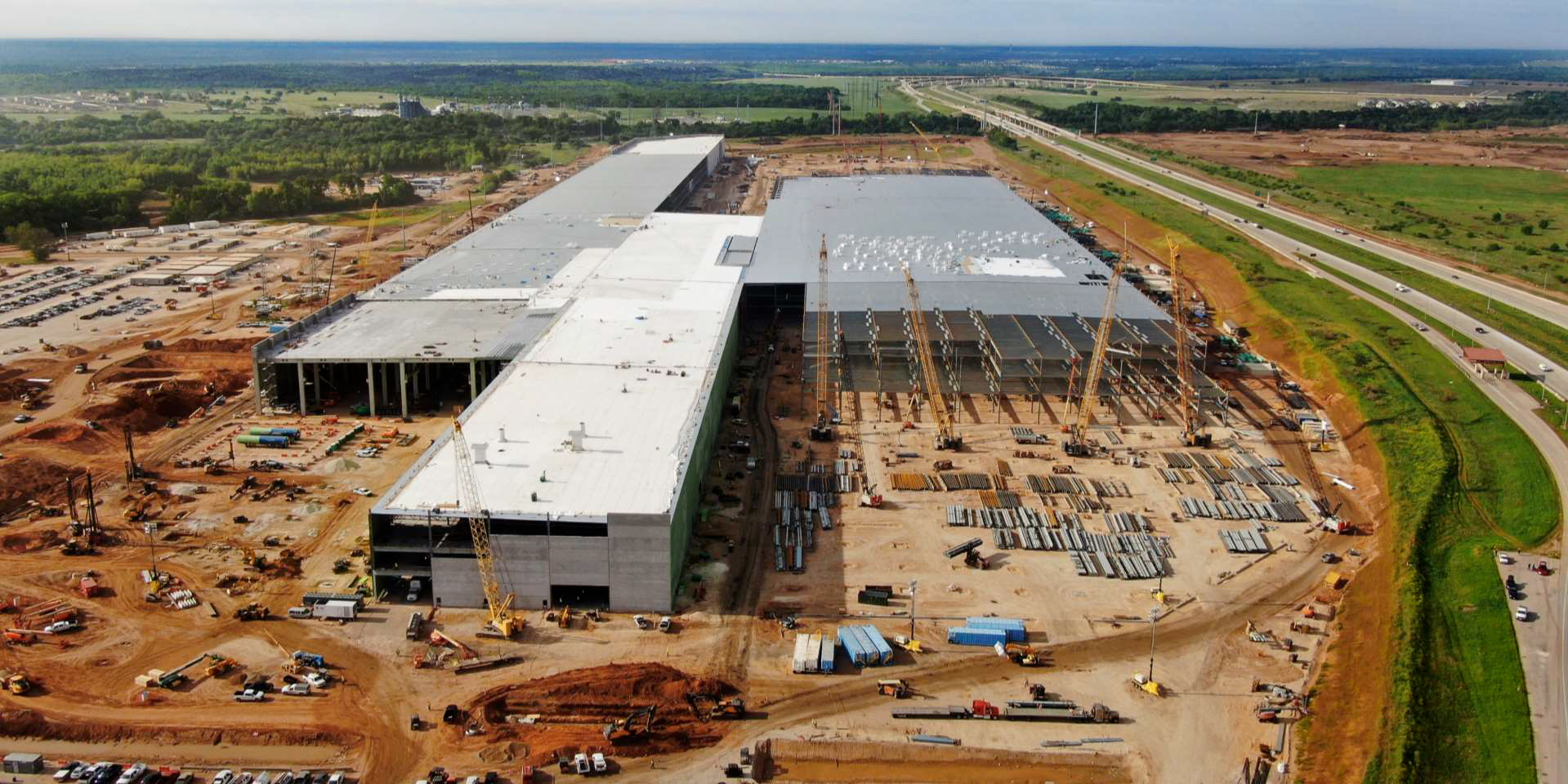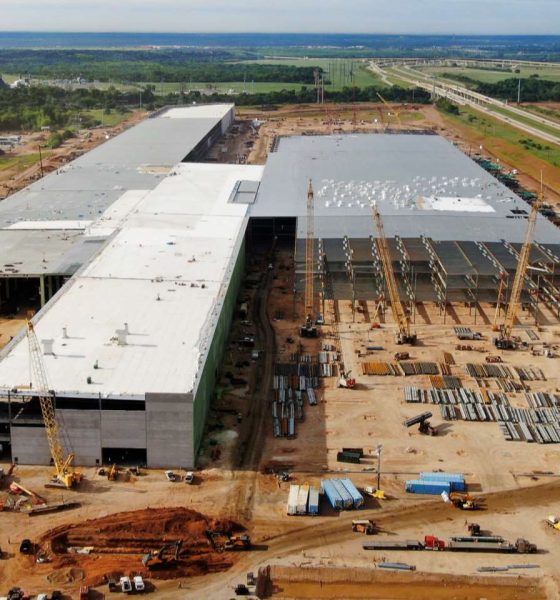There’s a saying in Texas that everything is bigger. New details about Tesla’s manufacturing plant just outside of Austin, known as Giga Texas, reveal that everything really is bigger in the Lone Star State, and Tesla is on its way to having the largest automotive manufacturing facility in the United States.
CEO Elon Musk detailed yesterday that the upcoming manufacturing plant just minutes outside of Austin will be “almost a mile long when complete,” making it so large that you likely have to see it to believe it. The automaker is nearing initial production at the plant, which is scheduled for later this year. While the world’s leading electric automaker might not produce a massive volume of vehicles at Giga Texas this year, you can bet that it will be one of Tesla’s biggest advantages in automotive manufacturing, especially in the United States, where demand for the company’s vehicles continues to grow.
I was at Giga Texas yesterday. Team is making excellent progress. Building will be almost a mile long when complete.
— Elon Musk (@elonmusk) July 25, 2021
On the list of the largest factories in the United States provided by RList, the massive 2.612 million square foot facility that Kia operates in West Point, Georgia, sits on more than 2,200 acres of land and had a hefty price tag of $1 billion. Kia has operated this plant since 2009, and it has remained the largest manufacturing factory in the United States since that time.
However, Giga Texas just may have the size to displace the massive Kia plant, putting it into second place if Musk’s calculations are true. After purchasing an additional 381 acres of land adjacent to the already 2,100 acres Tesla owned, the company is already planning to set its most advanced facility on the largest piece of land that a factory sits on in the country. 2,481 acres will outfit the estimated 1.7 million square feet that the main structure will sit on. The second facility will be an additional 900,000 square feet, with the final building tacking on another 1 million square feet, swamping the Kia facility with an estimated 3.6 million square feet of manufacturing floor space for Tesla to roam around on, a million square feet larger than the Georgia plant.
Dawn on Monday at GigaTexas! ?
Do you think we’ll get more details on Giga Texas & Berlin, Cybertruck, Model Y and Semi later today at the 2nd quarter results meeting?
Q2 2021 Update: https://t.co/AzftlaLG1N
? @JoeTegtmeyer pic.twitter.com/i3z6embrFZ— Austin Tesla Club (@AustinTeslaClub) July 26, 2021
To put this into perspective, the Tesla Fremont factory is only 510,000 square feet — and growing. However, Tesla’s flagship facility in the Northern California landscape has been a challenge for the automaker as production efforts increase and demand follows suit. The company has opted for temporary (and now permanent) spring structures to expand manufacturing space.
Musk added that Giga Texas is roughly seven stories tall, with every floor being “double in size.” Additionally, he expects the facility to grow by about 500 feet over time. He did not detail how he expects the facility to continue growing, but it could have something to do with the highly-speculated Project Bobcat that was listed in the Texas State public filings just a few months ago.
When Giga Texas begins production later this year, it will be responsible for Model Y, Cybertruck, Model 3, and Semi production for the Eastern half of North America.

News
Tesla FSD fleet is nearing 7 billion total miles, including 2.5 billion city miles
As can be seen on Tesla’s official FSD webpage, vehicles equipped with the system have now navigated over 6.99 billion miles.

Tesla’s Full Self-Driving (Supervised) fleet is closing in on almost 7 billion total miles driven, as per data posted by the company on its official FSD webpage.
These figures hint at the massive scale of data fueling Tesla’s rapid FSD improvements, which have been quite notable as of late.
FSD mileage milestones
As can be seen on Tesla’s official FSD webpage, vehicles equipped with the system have now navigated over 6.99 billion miles. Tesla owner and avid FSD tester Whole Mars Catalog also shared a screenshot indicating that from the nearly 7 billion miles traveled by the FSD fleet, more than 2.5 billion miles were driven inside cities.
City miles are particularly valuable for complex urban scenarios like unprotected turns, pedestrian interactions, and traffic lights. This is also the difference-maker for FSD, as only complex solutions, such as Waymo’s self-driving taxis, operate similarly on inner-city streets. And even then, incidents such as the San Francisco blackouts have proven challenging for sensor-rich vehicles like Waymos.
Tesla’s data edge
Tesla has a number of advantages in the autonomous vehicle sector, one of which is the size of its fleet and the number of vehicles training FSD on real-world roads. Tesla’s nearly 7 billion FSD miles then allow the company to roll out updates that make its vehicles behave like they are being driven by experienced drivers, even if they are operating on their own.
So notable are Tesla’s improvements to FSD that NVIDIA Director of Robotics Jim Fan, after experiencing FSD v14, noted that the system is the first AI that passes what he described as a “Physical Turing Test.”
“Despite knowing exactly how robot learning works, I still find it magical watching the steering wheel turn by itself. First it feels surreal, next it becomes routine. Then, like the smartphone, taking it away actively hurts. This is how humanity gets rewired and glued to god-like technologies,” Fan wrote in a post on X.
News
Tesla starts showing how FSD will change lives in Europe
Local officials tested the system on narrow country roads and were impressed by FSD’s smooth, human-like driving, with some calling the service a game-changer for everyday life in areas that are far from urban centers.

Tesla has launched Europe’s first public shuttle service using Full Self-Driving (Supervised) in the rural Eifelkreis Bitburg-Prüm region of Germany, demonstrating how the technology can restore independence and mobility for people who struggle with limited transport options.
Local officials tested the system on narrow country roads and were impressed by FSD’s smooth, human-like driving, with some calling the service a game-changer for everyday life in areas that are far from urban centers.
Officials see real impact on rural residents
Arzfeld Mayor Johannes Kuhl and District Administrator Andreas Kruppert personally tested the Tesla shuttle service. This allowed them to see just how well FSD navigated winding lanes and rural roads confidently. Kruppert said, “Autonomous driving sounds like science fiction to many, but we simply see here that it works totally well in rural regions too.” Kuhl, for his part, also noted that FSD “feels like a very experienced driver.”
The pilot complements the area’s “Citizen Bus” program, which provides on-demand rides for elderly residents who can no longer drive themselves. Tesla Europe shared a video of a demonstration of the service, highlighting how FSD gives people their freedom back, even in places where public transport is not as prevalent.
What the Ministry for Economic Affairs and Transport says
Rhineland-Palatinate’s Minister Daniela Schmitt supported the project, praising the collaboration that made this “first of its kind in Europe” possible. As per the ministry, the rural rollout for the service shows FSD’s potential beyond major cities, and it delivers tangible benefits like grocery runs, doctor visits, and social connections for isolated residents.
“Reliable and flexible mobility is especially vital in rural areas. With the launch of a shuttle service using self-driving vehicles (FSD supervised) by Tesla in the Eifelkreis Bitburg-Prüm, an innovative pilot project is now getting underway that complements local community bus services. It is the first project of its kind in Europe.
“The result is a real gain for rural mobility: greater accessibility, more flexibility and tangible benefits for everyday life. A strong signal for innovation, cooperation and future-oriented mobility beyond urban centers,” the ministry wrote in a LinkedIn post.
News
Tesla China quietly posts Robotaxi-related job listing
Tesla China is currently seeking a Low Voltage Electrical Engineer to work on circuit board design for the company’s autonomous vehicles.

Tesla has posted a new job listing in Shanghai explicitly tied to its Robotaxi program, fueling speculation that the company is preparing to launch its dedicated autonomous ride-hailing service in China.
As noted in the listing, Tesla China is currently seeking a Low Voltage Electrical Engineer to work on circuit board design for the company’s autonomous vehicles.
Robotaxi-specific role
The listing, which was shared on social media platform X by industry watcher @tslaming, suggested that Tesla China is looking to fill the role urgently. The job listing itself specifically mentions that the person hired for the role will be working on the Low Voltage Hardware team, which would design the circuit boards that would serve as the nervous system of the Robotaxi.
Key tasks for the role, as indicated in the job listing, include collaboration with PCB layout, firmware, mechanical, program management, and validation teams, among other responsibilities. The role is based in Shanghai.
China Robotaxi launch
China represents a massive potential market for robotaxis, with its dense urban centers and supportive policies in select cities. Tesla has limited permission to roll out FSD in the country, though despite this, its vehicles have been hailed as among the best in the market when it comes to autonomous features. So far, at least, it appears that China supports Tesla’s FSD and Robotaxi rollout.
This was hinted at in November, when Tesla brought the Cybercab to the 8th China International Import Expo (CIIE) in Shanghai, marking the first time that the autonomous two-seater was brought to the Asia-Pacific region. The vehicle, despite not having a release date in China, received a significant amount of interest among the event’s attendees.










